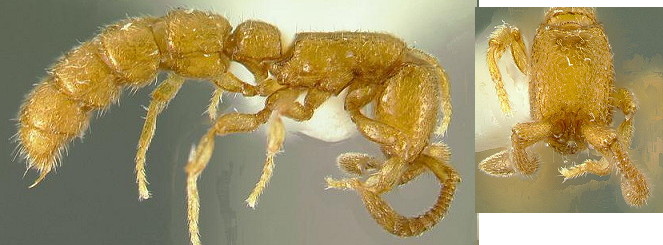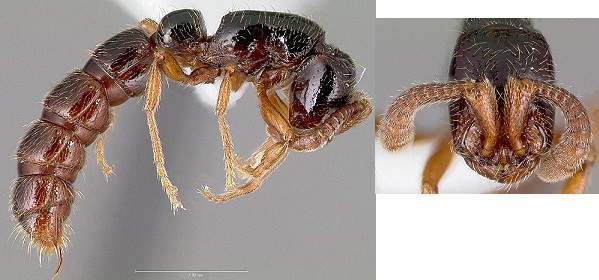SUBFAMILY CERAPACHYINAE - Genus Sphinctomyrmex Mayr
| The Ants of Africa SUBFAMILY CERAPACHYINAE - Genus Sphinctomyrmex Mayr |
Diagnostic Features - Each gastral segment separated from adjoining segments by distinct girdling constrictions; eyes absent.
Mayr's (1866b) illustrated genus definition is at ![]() . Santschi (1930a: 49) erected a new genus,
Aethiopopone, for the African species previously regarded by
himself (Santschi, 1915), he noted "not Mayr 1866", as Sphinctomyrmex
[see
. Santschi (1930a: 49) erected a new genus,
Aethiopopone, for the African species previously regarded by
himself (Santschi, 1915), he noted "not Mayr 1866", as Sphinctomyrmex
[see ![]() ]. He accompanied the
definition with a description of rufiventris var chariensis.
]. He accompanied the
definition with a description of rufiventris var chariensis.
Bolton (1995), however, has - "Aethiopopone Santschi, 1930a: 49.
Type species Sphinctomyrmex rufiventris by monotypy. Aethiopopone
junior synonym of Sphinctomyrmex: Bolton, 1973a:341; Brown,
1975: 31."
Described by Bolton (1973a) as rare and collected only from Berlese funnel extracts of forest leaf litter. Revision by Brown (1975). The two species from Africa are known only from males; the second species, Sphinctomyrmex chariensis is from the Central African Republic (Bolton, 1995). Elsewhere genus members are known to pursue an army ant life style, raiding other ants; the long jointed gaster appearing to be adaptive, allowing individuals to wrap around and protect the brood (Brown, 1975).
Brown (1975) commented on seeing other specimens apparently from West Africa. One from the Schönherr Collection in the Riksmuseet, deposited in 1848, had the lable "S. Leone/Afzelius", Adam Afzelius (1750-1838) had been a student of Linnaeus, who collected in or acquired material from Sierra Leone. He, Brown, felt it might be the female of one of the two Santschi species. A third species appears to have been found by Dr Jean Lévieux from in the soil at Lamto, Ivory Coast, but Brown noted the specimens had gone to Dr R W Taylor, who "several years ago expressed an interest in describing them; so far no description had appeared". Brown gave a brief description.
Borowiec (2016: 237 ff) placed chariensis and rufiventris in an otherwise almost wholly Australasian genus (with one in Thaliand), Zasphinctus Wheeler (1918), gen. rev. He reverted Sphinctomyrmex to being a wholly Neotropical genus, with three member species (Borowiec (2016: 214).
Hita Garcia et al (2017)
have added workers of three new species: Zasphinctus sarowiwai Hita Garcia
sp. n. [Cameroon, Democratic Republic of Congo,
Ghana, Ivory Coast, Uganda]; Zasphinctus
obamai Hita Garcia sp. n. [Kenya]; and, Zasphinctus wilsoni Hita Garcia
sp. n. [Mozambique] but did not revise the two old Sphinctomyrmex known only from
males.
References:
Borowiec ML (2016) Generic revision of the ant subfamily Dorylinae (Hymenoptera, Formicidae). Zookeys 608: 1–280. https://doi.org/10.3897/zookeys.608.9427
Wheeler WM (1918) The Australian ants of the ponerine tribe Cerapachyini. Proceedings of the American Academy of Arts and Sciences 53: 215–265. doi: 10.2307/25129989
Hita Garcia F, Fischer G, Liu C, Audisio TL, Economo EP (2017)
Next-generation morphological character discovery and evaluation: an
X-ray micro-CT enhanced revision of the ant genus Zasphinctus Wheeler
(Hymenoptera, Formicidae, Dorylinae) in the Afrotropics. ZooKeys 693:
33–93. https://doi.org/10.3897/zookeys.693.13012
| 1 | MALE, TL 4.5 mm; head and thorax brown black, rest yellow brown. Pilosity as type (rufiventris) main difference being the more regular posterior convexity of the head. Ocelli smaller and separated by their own diameter (separation less in the type). Second segment of funiculus nore than twice as long as wide; following segments two and a half times as long. Sides of propodeum puncturate like the rest, but with several longitudinal striae near the edge of the declivity, that has similar transverse fine striae. Petiole node, less regularly rounded dorsally, with a feebly concave dorsum. Discoidal fringe brown | Chad & Mali - chariensis |
| 2 | MALE, TL 4.5 mm; reddish brown; appendages and gaster reddish yellow; dorsum of gaster a little darker brown. Head and thorax with large irregular puncturations, more or less confluent on a smooth ground; puncturation of gaster finer and more spaced; sides of propodeum rugulo-reticulate. Fine long, decumbent pilosity, more erect on gaster; legs and antennae pubescent, latter very finely | Benin & Mali - rufiventris |
| 3 |  Probably the specimen shown by Bolton (1990) as rufiventris
but without any justification for the association of an identified male
with the worker Probably the specimen shown by Bolton (1990) as rufiventris
but without any justification for the association of an identified male
with the worker |
Sphinctomyrmex sp from Ivory Coast |
| -- |
Dark brown species |
4 |
| 4 |
With head in full-face view
median clypeal area with conspicuous tooth (Fig. 4E, H) and
torulo-posttorular complex comparatively long (Fig. 4H); in
posterodorsal view vertexal margin and posterior face of head weakly
developed; see CASENT0764654 |
West Africa to Uganda - sarowiwai |
| -- |
With head in full-face view
median clypeal area without any tooth (Fig. 4D, 4F, G, I) and
torulo-posttorular complex comparatively short (Fig. 4G, I); in posterodorsal view vertexal margin and posterior face of head strongly developed |
5 |
| 5 |
 With head in full-face view parafrontal
ridges with regularly shaped dorsal outline (Fig. 4I); petiolar tergum
in profile relatively higher, ca. 1.1 times longer than high (LPI 112)
ANTC37418 With head in full-face view parafrontal
ridges with regularly shaped dorsal outline (Fig. 4I); petiolar tergum
in profile relatively higher, ca. 1.1 times longer than high (LPI 112)
ANTC37418 |
type locality only in Mozambique - wilsoni |
| -- |
With head in full-face view parafrontal ridges with irregularly shaped dorsal outline (Fig. 4G); petiolar tergum in profile relatively lower, ca. 1.2 timeslonger than high (LPI 117–123) (Fig. 5M) CASENT0764125 (type location only) | Kenya - obamai |
| 5 |
 With head in full-face view parafrontal
ridges with regularly shaped With head in full-face view parafrontal
ridges with regularly shaped |
Sphinctomyrmex sp from Gabon |
|
© 2007, 2008, 2009, 2010, 2017 - Brian Taylor CBiol
FRSB FRES 11, Grazingfield, Wilford, Nottingham, NG11 7FN, U.K. |
href="sphinctomyrmex.htm"